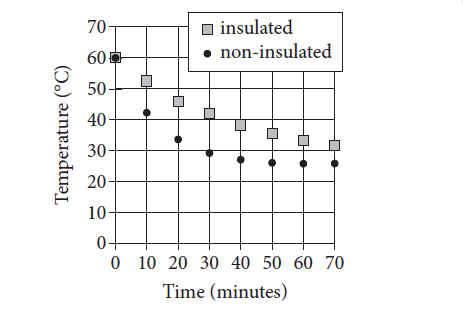Two samples of sulphur are heated separately starting at 60∘C. One sample is found to melt at 114∘C and the other one melts at 119∘C. How do you account for this?
(i) allotropes of sulphur
(ii) stability of allotropes at different temperatures
(iii) comparison of melting points of different allotropes
(iv) pattern of heating to be employed
(v) effect of pattern of heating on the allotropic transformation
Similar Questions
Two samples of sulphur are heated separately startirig at 60∘C. One sample is found to melt at 114∘C and the other one melts at 119∘C. How do you account for this
View SolutionA sample of water under supply was found to boil at 102∘C at normal temperature and pressure. It the water pure ? Will this water freeze at 0∘C ? Comment.
View Solution
Knowledge Check

Two samples of water of equal mass are heated to 60 degrees Celsius (°C). One sample is poured into an insulated container, and the other sample is poured into a non-insulated container. The samples are then left for 70 minutes to cool in a room having a temperature of 25°C. The graph above shows the temperature of each sample at 10-minute intervals. Which of the following statements correctly compares the average rates at which the temperatures of the two samples change?AIn every 10-minute interval, the magnitude of the rate of change of temperature of the insulated sample is greater than that of the non-insulated sample.BIn every 10-minute interval, the magnitude of the rate of change of temperature of the non-insulated sample is greater than that of the insulated sample.CIn the intervals from 0 to 10 minutes and from 10 to 20 minutes, the rates of change of temperature of the insulated sample are of greater magnitude, whereas in the intervals from 40 to 50 minutes and from 50 to 60 minutes, the rates of change of temperature of the non-insulated sample are of greater magnitude.DIn the intervals from 0 to 10 minutes and from 10 to 20 minutes, the rates of change of temperature of the non-insulated sample are of greater magnitude, whereas in the intervals from 40 to 50 minutes and from 50 to 60 minutes, the rates of change of temperature of the insulated sample are of greater magnitude.Two identical bodies are made of a material for which the heat capacity increases with temperature. One of these is at 100∘C. While the other one is at 0∘C. If the two bodies are brought into contact, then assuming no heat loss, the final common temperature is
ALess than 50∘C but greater than 0∘CB0∘CC50∘CDMore than 50∘CTwo identical bodies are made of a material for which the heat capacity increases with temperature. One of these is at 100∘C. While the other one is at 0∘C. If the two bodies are brought into contact, then assuming no heat loss, the final common temperature is
Aless than 50∘C but greater than 0∘CB0∘CC50∘CDmore than 50∘C
Two identical bodies are made of a material for which the heat capacity increases with temperature. One of these is at 100∘C. While the other one is at 0∘C. If the two bodies are brought into contact, then assuming no heat loss, the final common temperature is
View SolutionTwo bodies of different materials but of equal mass are heated at uniform rate under identical conditions from 0∘C one body start melting at 60∘C after heating for 2 minutes while the other start melting at 40∘C after heating for 4 minutes. the ratio of their specific heats is
View SolutionOne end of conducting rod is maintained at temperature 50∘C and at the other end ice is melting at 0∘C. The rate of melting of ice is doubled if:
View SolutionYou are given two samples of water labelled as 'A' and 'B'. Sample 'A' boils at 100∘C and sample 'B' boils at 102∘C. Which sample of water will not freeze at 0∘C? Comment.
View SolutionOne end of conducting rod is maintained at temperature 50∘C and at the other end ice is melting at 0∘C. The rate of melting of ice is doubled if:
View Solution
